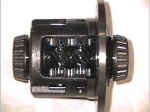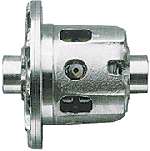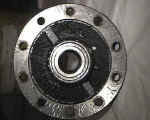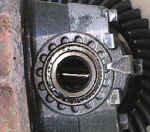
vs the Competition clutch type
 .
. By Randy Stocker - SOLOMIATA@aol.com
This question gets asked at least twice a month on Miata.Net, so here is the scoop.
(Q) How do I tell if I have a Limited Slip differential in my 1990-1993 Miata?
(A) You can't. There are no external markings on the housing to indicate a limited slip (both open and VLSD use a yellow colored fill cap). You could call Mazda Customer Relations (800-222-5500) with your VIN and just ask if it originally came with your car. There is misinformation out there that VLSD housings have cooling fins and open diffs have smooth housings. This is mostly incorrect. That rumor started because the first few hundred open diff housings to come on the Miata in 1990 were smooth, no fins. They changed them all to the finned version by about VIN #200. Even the attempt to lay a patch of two black marks on your driveway is not a telling attribute because the Miata is very well balanced and has equal weight on both tires as well as the IRS puts no twisting torque load on the tires either, an open diff Miata will also leave two black marks if you dump the clutch and peal out in a strait line.
A VLSD is made up of thin perforated plates that are suspended in a silicone fluid. The plates shear the fluid as the wheels rotate at different speeds. This shearing can equalize the different wheel rates thus limiting slippage. The VLSD only provides a 15-20% locking function when new, so they are not really meant to be a performance item. I have found that the locking action of the VLSD takes a moment to activate when one wheel starts to slip so it usually takes affect after you have already exited the corner. They are really meant to help you get the car moving from a dead stop in slippery conditions and not a performance aid. The VLSD works just fine for it's intended street usage but it will effectively stop limiting slip, from a performance point of view, at some point as the plates can break, the silicone fluid can leak and the tolerance between the plates can wear. For more detail information on how a VLSD operates check out the links page for the BMW and 4x4 articles.
The shop manual states to test a VLSD you put a torque wrench on the hub (wheel in the air) and turn 90 degrees with 11 ft lbs of torque (car in gear). This should take no less than 4 seconds. If less then you have either an open diff or the VLSD is toast. Another test for a good VLSD is to jack up the rear with both rear wheels in the air. A good VLSD will turn both rear wheels in the same direction when manually turning the drive shaft. The open unit (or toasted VLSD) will turn the wheels in the opposite directions. There is no rebuild kit for the VLSD and the unit is completely sealed so you can't even get inside it short of cutting it
The only replacement unit for the early diff that has been used extensively is the competition clutch style LSD available from Mazda Competition or MazdaSpeed. (Cusco and Kaaz also make a replacement clutch style unit but I have heard little about them). UPDATE 8/6/98: I was recently informed that OPM in Cummings GA will convert an open diff to a clutch type LSD for about $600. I have no information on these except that this is the unit some ITA racers are using.
A Torsen type LSD is an upgrade for the early unit but requires replacing the entire diff housings assembly from the later 1994-> generation cars as they are completely different units. See Dennis Nutting's Torsen upgrade page for more on their installation reports. See also the Miata.Net Garage for other swap info.
(Q) What is the pros and cons of the Torsen 
vs the Competition clutch type  .
.
(A)
Torsen Type: Superior torque rating of both the diff and the ring/pinion over the early unit. If longevity is an issue the Torsen is hands down the winner since it will also never wear out. Comes with 4.10:1 gears in 94-97, 4.30:1 in '99 and 3.909 with the 6-speed. It's action is superior to the VLSD and the clutch type LSD's for autox situations because it is basically an open diff until about 2/3's the way through the corner then it locks the *outside* wheel to about 40-45%. The Torsen action helps prevent a push in super tight corners. The one downside of the Torsen is that if one wheel is completely off the ground (zero traction) then the charactoristics of the Torsen will make it basically an open diff, both wheels have to have at least some traction for the unit to function properly. For more detail information on how a Torsen functions check out the links page for the BMW, 4x4, and whitepaper articles.
Competition Clutch Type: Not all that great in autox situations because it can cause a push at corner entry and power-on corner exit since it is always in a lock state. Better for drag launches and track events where you will be accelerating in more of a strait line than in autox. Still susceptible to breaking the ring/pinion teeth of the weak early rear.
FYI, The '84-88 NA RX7 Clutch type LSD will bolt into the later 1994+ Miata housing with minor grinding of the interior of the housing (the 1989-91 RX7 is a viscous). If you will be drag racing or road racing the car then you could concider that combo since it will better launch the power of a highly modified motor . This unit does have replacable plates. Also, if can't find a 1994+ Miata rear in a salvage yard then try the rear aluminum housing from a '86-91 RX7, they are nearly the same. You'll still need the short pinion cast iron front housing from the 94+ Miata (for the PPF mounting) and Miata specific rubber mounting bushings. That's what I did.
Mazda OEM Gears currently available for the later 1994 differential assembly are 3.909:1, 4.10:1, 4.30:1, 4.44:1. Mazda has discontinued the 4.65:1 (Japan market van) and 3.636:1 (79-82 RWD 626) gears but might be found used. Steeper aftermarket racing gears can be had in 4.875:1 and 5.125:1 from Mazda Competition. FYI, the 4.44:1 came as original equipment on 1987-88 4x4 trucks on the front axle and the 3.909 also came as original equipment on the 84-85 GSL-SE automatic.
**NEW** See how to install a RX7 TurboII rear into a Miata from Pete Doak's page
(Q)How do you identify Torsen's without dissasembly?
(A)The Torsen won't always turn both wheels when you turn the driveshaft, sometime if they are cold they will. One way is to take out the fill plug to see the Torsen gears which is hard to do because of the angle. Another way is to attempt to turn both half shafts in the same direction at the same time (tranny in neutral), can't be done with a Torsen. The foolproof way is to pull the stub axle on the type 1 or the drive axle on the type two. If you don't see a bar and can see directly thru the diff. it is a Torsen. If there is a bar, (spider gears) it's an open.
No bar=Torsen  Bar = open or
RX-7 clutch type
Bar = open or
RX-7 clutch type 
MazMart has noticed that the type 2 Torsen diffs were put into production during 3/1995. They are usually charactorized by the use of the single half shaft that goes directly into the diff housing instead of the prior stub shaft and flange mounting assembly.
(Q)Will a Torsen LSD fit in an open differential equipped 1994+ rear?
(A)Yes, the Torsen drops right in place of the open diff. No additional parts are needed unless you want to replace the halfshaft seals (always a good idea). The bearing are the same (last I checked the Torsen actually came with the bearings already installed). It is also unlikely that they will need a crush collar since they should be able realign the ring and pinion to it's original set with just the bearing backlash .
Please search the Miata.Net Archives for basic or common questions like this.
| Back to the Garage |
16 October, 2002 |